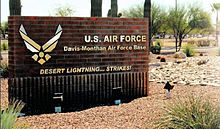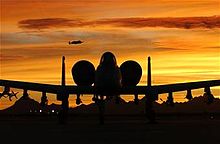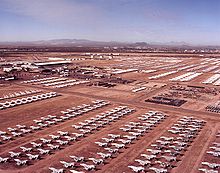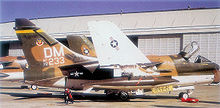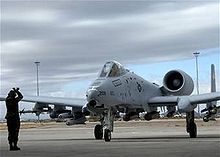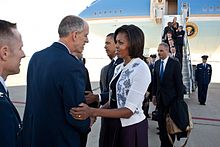- Davis–Monthan Air Force Base
-
Davis–Monthan Air Force Base Part of Air Combat Command (ACC) Located near: Tucson, AZ 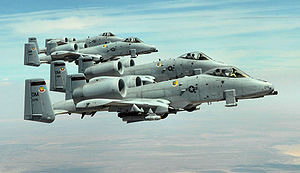
Four A-10s from Davis-Monthan fly in formation over ArizonaCoordinates 32°09′59″N 110°52′59″W / 32.16639°N 110.88306°W Built 1925 In use 1941-Present Controlled by  United States Air Force
United States Air ForceGarrison 
355th WingAirfield information IATA: DMA – ICAO: KDMA – FAA LID: DMA Summary Elevation AMSL 2,704 ft / 824 m Website Runways Direction Length Surface ft m 12/30 13,643 4,158 PEM Davis–Monthan Air Force Base (DM AFB) (IATA: DMA, ICAO: KDMA, FAA LID: DMA) is a United States Air Force base located within the city limits, and approximately 5 miles (8.0 km) south-southeast of downtown, Tucson, Arizona.
The host unit at Davis–Monthan is the 355th Fighter Wing (355 FW) assigned to Twelfth Air Force, which is headquartered at DM and is part of Air Combat Command (ACC). The 355 FW and various tenant units located on base provide A-10 Thunderbolt II close air support; OA-10 forward air controllers; air liaison officers; EC-130 command, control and communications warfare; air control radar; combat search and rescue; and combat support forces to unified commanders. The 355 FW also provides initial and recurrency flying training to all U.S. Air Force A/OA-10 and EC-130 pilots and crews; and is the ACC's executive agent for INF and START treaty compliance. Although under ACC, it is best known for its role as the location of the Air Force Materiel Command's 309th Aerospace Maintenance and Regeneration Group (AMARG), better known as the sole aircraft boneyard for all excess military and government aircraft, as its location allows for preservation of the aircraft.
Davis–Monthan AFB was established in 1925 as Davis-Monthan Landing Field, and is named in honor of World War I pilots Lieutenants Samuel H. Davis and Oscar Monthan, both Tucson natives. The commander of the 355th FW is Colonel John Cherrey. The Command Chief Master Sergeant is CMSgt Vincent Howard.
Contents
Overview
Davis–Monthan Air Force Base is a key ACC installation. The 355 FW is the host unit providing medical, logistical, mission support, and operational support to all assigned units. The wing's missions are to train A-10 and OA-10 pilots and to provide A-10 and OA-10 close support and forward air control to ground forces worldwide. One of the wing's tenant units, the 55th Electronic Combat Group, is tasked to provide command, control, and communications countermeasures in support of tactical forces with its EC-130H aircraft and, employing the EC-130E aircraft, provide airborne command, control, and communications capabilities for managing tactical air operations in war and other contingencies worldwide. Two other major tenants, the 563rd Rescue Group (structured under the 23d Wing, Moody Air Force Base) and 943rd Rescue Group, (structured under the 920th Rescue Wing, Patrick Air Force Base), are tasked to provide combat search and rescue support worldwide.
Although under ACC, it is best known for its role as the location of the Air Force Materiel Command's 309th Aerospace Maintenance and Regeneration Group (AMARG), better known as the sole aircraft boneyard for all excess military and government aircraft. Davis-Monthan was selected due to its low humidity and hard, alkaline soil, which allows the aircraft to be naturally preserved for cannibalization or possible reuse.
Wing units
The host wing at Davis-Monthan is the 355th Fighter Wing, which includes:
- 355th Operations Group
- consists of six squadrons and over 450 personnel employing 82 A-10 aircraft and an AN/TPS-75 radar system. It provides war-fighters with forces for close air support (CAS), air interdiction (AI), forward air control (FAC), combat search and rescue (CSAR), ground based tactical air control, and airbase operations. It also conducts all formal course directed aircraft initial qualification/ re-qualification training. All active duty aircraft assigned to Davis-Monthan Air Force Base carry the tail code "DM".
-
- 354th Fighter Squadron (A-10C) Bulldogs Blue Fin Flash
- 357th Fighter Squadron (A-10C) Dragons Yellow Fin Flash
- 358th Fighter Squadron (A-10A) Lobos Black Fin Flash
- 355th Operations Support Squadron
- 355th Training Squadron
- 607th Air Control Squadron
- West Coast A-10 Demonstration Team
-
- Consists of 12 members and is assigned to the 355th Operations Group. The team's primary mission is to encourage retention and recruitment by showcasing the Air Force's premier fighter/attack aircraft, the rugged and dependable A-10 Thunderbolt II. Performing at more than 30 air shows annually before 15 million spectators worldwide, the A-10 Demo Team provides insight about Air Combat Command and the United States Air Force.
- 355th Mission Support Group
- Consists of about 2,000 military and civilian personnel in six diverse squadrons that train, equip and provide agile combat mission support, including civil engineering, communications, contracting, transportation, fuels, supply, deployment readiness, personnel, security forces, and services for immediate worldwide deployment of combat support elements. The group also provides an effective in-garrison support infrastructure and quality of life services for 26 wing and 32 associate units spanning a 60,000-person, 10,763 acres (43.56 km2) community, one of the largest in Air Combat Command.
-
- 355th Civil Engineer Squadron
- 355th Communications Squadron
- 355th Contracting Squadron
- 355th Force Support Squadron
- 355th Logistics Readiness Squadron
- 355th Security Forces Squadron
- 355th Maintenance Group
- Supports eight flying squadrons comprising 82 A-10, 14 EC-130, 8 HH-60, and 6 HC-130 combat-ready aircraft with over 1,700 assigned personnel. It ensures quality of on- and off-equipment aircraft maintenance and executes an annual O&M budget of $1.5M.
- 355th Medical Group
- Ensures that personnel are medically ready to fight; train and to equip fully deployable medical teams; and meet the health care needs of our patients. Our goal is to maintain combat medical readiness of the 355 FW for global contingencies with an authorized staff of 395, a resource allocation exceeding $37 million, and 21 mobility teams, including Expeditionary Medical Support teams. The 355 MDG strives to provide timely and comprehensive medical services, promote both health and wellness of more than 50,000 Department of Defense beneficiaries, and build a resilient community at Davis-Monthan AFB.
Tenant Units
- Headquarters, Twelfth Air Force
- 612th Air Operations Group
- 612th Air Communications Squadron
- 612th Air Intelligence Squadron
- 612th Air and Space Operations Center - operates AFSOUTH's Combined Air and Space Operations Center (CAOC))
- 612th Air Operations Group
- 563d Rescue Group
- 48th Rescue Squadron (Pararescue)
- 55th Rescue Squadron (HH-60G Pavehawk)
- 79th Rescue Squadron (HC-130P)
- 563rd Operations Support Squadron
- 55th Electronic Combat Group
- 41st Electronic Combat Squadron (EC-130H) "Scorpions" Blue Tail Stripe
- 42d Electronic Combat Squadron (EC-130H) "Raptors" Yellow Tail Stripe
- 43d Electronic Combat Squadron (EC-130H) "Bats" Red Tail Stripe
- 309th Aerospace Maintenance and Regeneration Group (AMARG), (Air Force Material Command) - This group is responsible for the base's aircraft "graveyard", the largest in terms of number of planes in the world,[1] where old military and other aircraft are stationed either to be stored indefinely, pulped, stripped or restored for service.[2][3][4]
- 943rd Rescue Group - Air Force Reserve Command unit assigned to Davis-Monthan that falls under the 920th Rescue Wing (920 RQW) at Patrick AFB, Florida.
- 305th Rescue Squadron (HH-60G)
- 306th Rescue Squadron
- 943rd Operations Support Flight
- 214th Reconnaissance Group (214 RG) - Arizona Air National Guard unit flying the MQ-1 Predator.
The base provides additional active duty support to the 162d Fighter Wing (162 FW) of the Arizona Air National Guard, located at nearby Tucson International Airport, which flies the F-16C and F-16D Fighting Falcon.
Other military activities and federal agencies using the base include Navy Operational Support Center Tucson, a detachment of the Naval Air Systems Command, the Federal Aviation Administration, the U.S. Customs Service Air Service Branch, the U.S. Army Corps of Engineers, and the Federal Law Enforcement Training Center. Also located on base is the 25th Operational Weather Squadron 25 OWS. The squadron produces forecasts for the Western United States and is part of the 1st Weather Group (1 WXG) headquartered at Offutt Air Force Base, Neb. The squadron also serves as a training hub for new weather professionals - both enlisted and officers.
History
The base was named in honor of Lieutenants Samuel H. Davis and Oscar Monthan, two Tucsonans and World War I–era pilots who died in separate military aircraft accidents. Davis, who died in a Florida aircraft accident in 1921, attended the University of Arizona prior to enlisting in the Army in 1917. Monthan enlisted in the Army as a private in 1917, was commissioned as a ground officer in 1918, and later became a pilot. He was killed in a crash of a Martin bomber in Hawaii in 1924.
Origins
In 1919 the Tucson Chamber of Commerce aviation committee established the nation's first municipally-owned airfield at the current site of the Tucson Rodeo Grounds. The rapid increase in aviation activities meant a move in 1927 to the site which is now Davis–Monthan Air Force Base. After the City of Tucson acquired land southeast of town for a runway in 1925, Charles Lindbergh, fresh from his nonstop crossing of the Atlantic Ocean, flew his "Spirit of St. Louis" to Tucson in 1927 to dedicate Davis-Monthan Field, then the largest municipal airport in the United States.
Standard Airlines, later absorbed by American Airlines, had regular flights to and from Tucson in 1928. Military presence at the field began when Sergeant Simpson relocated his fuel and service operation to the site on 6 October 1927. He kept a log containing names of the field's customers, including Lindbergh, Amelia Earhart, Benjamin Foulois, and Jimmy Doolittle. Doolittle, awarded the Medal of Honor for his 1942 Tokyo raid, was the first military customer at the field on 9 October 1927. The combination of civil and military operations worked well until the early 1940s when military requirements began to require the relocation of civil aviation activities.
World War II
Davis-Monthan Airport became Tucson Army Air Field in 1940 as the United States prepared for World War II. The first assigned U.S. Army Air Corps units were the 1st Bomb Wing, 41st Bomb Group, and 31st Air Base Group, activating on 30 April 1941. In its military role, the base became known as Davis-Monthan Army Air Field on 3 December 1941. Even before Pearl Harbor on December 7th, 1941, Air Corps leaders started to increasingly utilize the airfield, sending Boeing B-29 Superfortresses and Consolidated B-24 Liberator heavy bombers and Douglas B-18 Bolo which were used both for training and observation missions.
Several known bombardment groups trained at DM during the war:
- 34th Bombardment (Heavy) 13 May 1942 – 4 July 1942
- 94th Bombardment (Heavy) August 1942 – 1 November 1942
- 302nd Bombardment (Heavy) 23 June 1942 – 30 July 1942
- 308th Bombardment (Heavy) 20 June 1942 – 1 October 1942
- 380th Bombardment (Heavy) 4 November 1942 – 2 December 1942
- 382nd Bombardment (Heavy) 23 January 1943 – 5 April 1943
- 389th Bombardment (Heavy) 24 December 1942 – 1 February 1943
- 392nd Bombardment (Heavy) 26 January 1943 – 1 March 1943
- 399th Bombardment (Heavy) 1 March 1943 – 10 April 1943
- 400th Bombardment (Heavy) April 1943 – 2 May 1943
- 446th Bombardment (Heavy) 1 April 1943 – 8 June 1943
- 449th Bombardment (Heavy) 1 May 1943 – 5 July 1943
- 451st Bombardment (Heavy) 1 May 1943 – 3 June 1943
- 459th Bombardment (Heavy) 20 September 1943 – 1 November 1943
- 466th Bombardment (Heavy) 15 August – 17 October 1945
- 486th Bombardment (Heavy) 9 November 1943 – March 1944
- 489th Bombardment (Heavy) 3 April 1945 – 13 July 1945
- 491st Bombardment (Heavy) 1 October 1943 – 11 November 1943
- 444th Bombardment (Very Heavy) 1 March 1943 – 29 July 1943
- 499th Bombardment (Very Heavy) 20 November 1943 – 1 December 1943
Training at the airfield came to a halt on August 14, 1945, when the Japanese unconditionally surrendered. Davis-Monthan played a post-war role by housing German POW's from June 1945 to March 1946.
Postwar years
With the end of the war, operations at the base came to a virtual standstill. It was then the base was selected as a storage site for hundreds of decommissioned aircraft with the activation of the 4105th Army Air Force Unit. The 4105th oversaw the storage of excess B-29s and C-47 "Gooney Birds." Tucson's dry climate and alkali soil made it an ideal location for aircraft storage and preservation, a mission that has continued to this day. The airfield also acted as a separation center, which brought the base populace to a high of 11,614 people in September 1945.
Cold War
The Cold War era was ushered in at Davis-Monthan in March 1946, in the form of the 40th and 444th Bombardment Groups, both equipped with B-29s. As part of the postwar austerity, these groups were inactivated, with the personnel and equipment being consolidated into the 43d Bombardment Group in October. On 11 January 1948, with the establishment of the United States Air Force, the facility was renamed Davis–Monthan Air Force Base. On 30 June 1948, the Air Force activated the 43rd Air Refueling Squadron, whose KB-29Ms were newly equipped with aerial refueling equipment purchased from the British firm FRL. The 43rd ARS, along with the 509th ARS at Walker AFB, New Mexico, was the first dedicated air refueling unit in history.
On 2 March 1949, the Lucky Lady II, a B-50A of the 43d Bombardment Wing, completed the first nonstop round-the-world flight, having covered 23,452 miles (37,742 km) in 94 hours and 1 minute (249.45 mph). Lucky Lady II was refueled four times in the air by KB-29 tankers of the 43d Air Refueling Squadron, which had made only one operational air refueling contact before the mission. For this outstanding flight, the Lucky Lady II's crew received the Mackay Trophy, given annually by the National Aeronautic Association for the outstanding flight of the year, and the Air Age Trophy, an Air Force Association award, given each year in recognition of significant contributions to the public understanding of the air age.
In 1953, the jet age came to Davis-Monthan when SAC units on the base converted to the new Boeing B-47 Stratojet. The 303d Bombardment Wing, Medium, was initially established on 27 August 1951, and activated at Davis-Monthan AFB on 4 September 1951. The wing operated B-29s until January 1952, when it was equipped with KB-29s. On 20 January 1953, the 303d transitioned to the Boeing B-47 Stratojet for its three bomb squadrons, while an additional air refueling squadron equipped with KC-97s was assigned to the wing between 18 February 1953, and 1 February 1956. A standard SAC Alert Area ramp was constructed in the southeast corner of the base adjacent to the runway and the 303d assumed nuclear alert responsibilities was final conversion and checkout in the B-47 was complete.
In April 1953 the Air Defense Command's (ADC) 15th Fighter-Interceptor Squadron was activated with F-86A Sabres. A year later, the unit transitioned into F-86Ds followed by a transition to F-86Ls in the fall of 1957. In the spring of 1959 the unit received Northrop F-89J interceptors which it flew for only a year when it transitioned into McDonnell F-101Bs. On 24 December 1964, the 15th FIS was deactivated.
In 1962, the Strategic Air Command's 390th Strategic Missile Wing (390 SMW) and its 18 Titan II ICBM sites around Tucson were activated. The 390 SMW was one of only three Titan II missile wings in SAC and represented the heaviest land-based missile and the largest single warhead ever fielded by U.S. strategic deterrent forces.
In July 1963, the 4028th Strategic Reconnaissance Weather Wing, equipped with U-2 strategic reconnaissance aircraft, began flying global missions from Davis-Monthan. Following the Cuban Missile Crisis in 1963, the 4080th Strategic Reconnaissance Wing at Laughlin AFB, Texas, relocated to the base and assumed responsibility for all U-2 operations, emphasizing long-range strategic reconnaissance and intelligence collection. As a Strategic Air Command (SAC) unit, the 4080th was later redesignated the 100th Strategic Reconnaissance Wing and also acquired Lockheed DC-130 Hercules aircraft for launch and control of Firebee reconnaissance drones that were the precursors of contemporary unmanned aerial systems. The DC-130s and U-2s remained at the Davis-Monthan until 1976, when the 100 SRW was inactivated, its DC-130s transferred to Tactical Air Command's 432d Tactical Drone Group, and its U-2s transferred to SAC's 9th Strategic Reconnaissance Wing (9 SRW) at Beale Air Force Base, California, where U-2 Dragon Lady operations were consolidated with SR-71 Blackbird operations.
On 15 June 1964, Davis-Monthan's 303d Bombardment Wing was inactivated as part of the retirement of the B-47 Stratojet from active service. The year 1964 brought back the combat crew training mission of the World War II years with the 4453d Combat Crew Training Wing equipped with the Air Force's newest and most sophisticated fighter, the McDonnell Douglas F-4 Phantom II. In July 1971, the 355th Tactical Fighter Wing, flying the A-7 Corsair II aircraft, was activated at the base and the previously assigned F-4s were moved to Luke AFB, near Phoenix, Arizona.
On 1 October 1976, the base was transferred to Tactical Air Command (TAC) after 30 years under SAC. It was also that year the 355th Tactical Fighter Wing accepted the first A-10 Thunderbolt II. Since 1979, D-M has been the training location for pilots in the A-10; the base was redesignated the 355th Tactical Training Wing on 1 September 1979. The organization was later redesignated the 355th Fighter Wing since it includes operational, deployable A-10 squadrons in addition to its CONUS training mission
The 1980s brought several diverse missions to D-M. The headquarters charged with overseeing them was now the 836th Air Division, which was activated 1 January 1981. The AD advised Air Force component commanders and land forces on A-10 aircraft tactics, training, employment and readiness, and subordinate units participated in exercises such as Red Flag and Celtic Echo.
The 41st Electronic Combat Squadron [5], equipped with the EC-130H Compass Call aircraft, arrived on 1 July 1980, and reported to the 552d Airborne Warning and Control Wing. In 1981 D-M welcomed the 868th Tactical Missile Training Group. The 868th was the only U.S.-based Ground Launched Cruise Missile (GLCM) unit and the source of the crews that staffed the forward deployed GLCM wings in NATO in 1982.
On 1 September 1982, the headquarters of the 602nd Tactical Air Control Wing (TAIRCW) and its subordinate 23rd Tactical Air Support Squadron (TASS), a unit responsible for the Air Force's tactical air control system west of the Mississippi River transferred from Bergstrom Air Force Base, Texas, and stood up at D-M, bringing 16 OA-37B aircraft and numerous new personnel to the base. The 23rd TASS became the Air Force's first O/A-10 squadron in 1988, providing heavily armed airborne forward air control (FAC) capability for the first time. Unlike all other D-M aircraft at the time, the 23rd TASS fleet's tail flash read "NF", for "Nail FAC"; the squadron's radio call sign was "Nail."
In 1984, as a result of the first series of Strategic Arms Reduction Treaties START I between the United States and the Soviet Union, SAC began to decommission its Titan II missile system. In 1982, the 390 SMW began removing its 18 missiles and inactivating the associated sites in preparation for eventual demolition.
In October 1981, President Ronald Reagan announced that, as part of the strategic modernization program, Titan II systems were to be retired by 1 October 1987. Deactivation began at Davis-Monthan on 1 October 1982. During the operation, titled "Rivet Cap", the missiles were removed and shipped to Norton AFB, California for refurbishment and storage. Explosive demolition began at the headworks of missile complex 570-7 on 30 November 1983. In May 1984, the 390 SMW's last Titan II at Davis-Monthan came off alert status. SAC subsequently deactivated the 390th Strategic Missile Wing on 30 June 1984.
One site under the 390 SMW, known both as Titan II Site 571-7 and as Air Force Facility Missile Site 8, was initially decommissioned in 1982. Located approximately 12 miles (19 km) south of Tucson in Sahuarita, Arizona, it was saved from demolition and turned over to the Arizona Aerospace Foundation, a nonprofit organization which also administers the Pima Air and Space Museum immediately south of Davis-Monthan. With a variety of items on loan from the National Museum of the United States Air Force, including an inert Titan II missile, Site 571-7 is now known as the Titan Missile Museum and is the sole remaining example of a Titan II missile site in existence. In 1994, the site was declared a National Historic Landmark.
Modern era
In the 1990s, the 355 TTW continued to train A-10 crews for assignments to units in the United States, England, and Korea. During this period, the 355 FW deployed Airborne Forward Air Controllers in their OA-10 aircraft to Operation Desert Storm, providing nearly 100 percent of this capability to the war.
On 1 October 1991, the 355 TTW was redesignated as the 355th Fighter Wing (355 FW) in tune with the Air Force's Objective Wing philosophy. The 355th Fighter Wing was composed of the 355th Operations Group (355 OG), the 355th Maintenance Group (355 MG), the 355th Medical Group (355 MDG), and the 355th Mission Support Group (355 MSG).
In May 1992, the 41st and 43d Electronic Combat Squadron, flying EC-130E Hercules Compass Call arrived. The aircraft carried an airborne battlefield command and control center capsule that provides continuous control of tactical air operations in the forward battle area and behind enemy lines. This capability added yet more strength to the wing's combat capability. The 43rd Electronic Combat Squadron "Bats" are part of the 55th Wing (55 WG) at Offut AFB, Nebraska, but operate out of Davis-Monthan. In addition, the 42d Airborne Command and Control Squadron arrived from Keesler AFB, Mississippi on 19 July 1994.
On 1 May 1992, senior Air Force leaders implemented the policy of one base, one wing, one boss. The 836 AD and 602 TAIRCW inactivated while the 41 ECS and 43 ECS came under control of the 355 FW. With the mission diversified, the 355th Fighter Wing was redesignated as the 355th Wing (355 WG). Following Operation Desert Storm, the 355 WG supported Operation Southern Watch during deployments to Al Jaber, Kuwait, in 1997 by deploying 24 A-10s, in 1998 by deploying 16 A-10s, and in 1999 by deploying 14 A-10s—all to ensure compliance of the 33rd parallel southern no-fly zone. The flight and mysterious crash of Captain Craig D. Button took off from Davis–Monthan Air Force Base on 12 April 1997.
Global War on Terrorism
The attacks on 11 September 2001, led to the initiation of three ongoing missions: Operation Enduring Freedom (OEF), Operation Iraqi Freedom (OIF), and Operation Noble Eagle (ONE).
After the execution of Operation Enduring Freedom, eight A-10s from the 355 WG were called to Bagram Air Base, Afghanistan, to fly close air support missions supporting multinational ground forces.
In September 2002, the 48th, 55th, and the 79th Rescue Squadron's (RQS) transferred under control of the 355 WG, equipped with HC-130 aircraft and HH-60 helicopters. At the same time, the 41st and 43d Electronic Combat Squadrons were realigned under the control of the 55th Electronic Combat Group (55 ECG). While personnel and aircraft remained on Davis-Monthan AFB, operational control of the 55 ECG was assumed by the 55th Wing at Offutt AFB, Nebraska. Another major wing realignment occurred on 1 October 2003, with the activation of the 563rd Rescue Group (563 RQG) on Davis-Monthan AFB. Control of the 48th, 55th, and 79th Rescue Squadrons (RQS) was passed to the new group with the 23rd Wing (23 WG) at Moody Air Force Base, Georgia assuming operational command of the unit.
In 2003 and 2005, the 354th Fighter Squadron (354 FS) "Bulldogs" deployed on five-month deployments to Bagram Air Base in Afghanistan. During these deployments, they provided 24-hour presence to reassure the Afghan population as it struggled with its emergent democracy, and provided key support during national elections. While the 2003 deployment saw limited action, the Bulldogs employed over 22,000 rounds of 30 mm during 130 troops-in-contact situations during the 2005 deployment. Returning to Afghanistan in April 2007 for another six-month deployment, the 345th again provided 24-hour presence and Close Air Support expertise to coalition forces in support of Operation Enduring Freedom. During this period, insurgent activity level was the highest recorded to date in OEF. The Bulldogs employed an unprecedented number of munitions during this deployment—over 150,000 rounds of 30 mm in support of over 400 troops-in-contact situations.
Another major change occurred on 26 April 2007. With only A-10 fighter aircraft assigned, the 355th Wing was redesignated once again as the 355th Fighter Wing (355 FW). Also in 2007, the 214th Reconnaissance Group (214 RG), an Arizona Air National Guard unit, was activated. Today, the 355 FW is composed of four groups: the 355th Operations Group (355 OG), the 355th Maintenance Group (355 MG), the 355th Mission Support Group (355 MSG), and the 355th Medical Group (355 MDG). Together, along with their tenant organizations, they make up the 6,000 Airmen and 1,700 civilian personnel at Davis-Monthan AFB.
On Friday, 16 September 2011, the Base was placed on lockdown; news agencies reported shots may have been fired, possibly with injuries (the military spokesperson later said this was not the case, the base was simply on alert because an armed individual walked on to and was holed up in a building on the base). An ambulance had been called, but that was coincidental- a case of bad timing- as it was meant for a woman that had gone into labor. The military spokesperson, Technical Sergeant Russ Martin, stated that in fact there were no injuries or shots fired. No one is allowed on or off the Base; all students were accounted for. Because of the lockdown, there was a single point of entry at the Base. Later, the lockdown was ended; the situation apparently was peacefully resolved.[6]
Previous names
- Established as: Davis-Monthan Landing Field, 1 November 1925
- Tucson Municipal Airport, 6 October 1927
- Davis-Monthan Field, 3 December 1941
- Davis-Monthan AFB, 13 January 1948–present
Major commands to which assigned
- Fourth Air Force, 1 February 1942 – 8 February 1943
- Second Air Force, 8 February 1943 – 16 November 1945
- Air Technical Service Command, 16 November 1945 – 31 March 1946
- Strategic Air Command, 31 March 1946 – 1 October 1976
- Tactical Air Command, 1 October 1976 – 1 June 1992
- Air Combat Command, 1 June 1992 – present
Major units assigned
- 41st Bombardment Group, 15 January – 14 May 1941
- 31st Air Base Group, 30 April 1941 – 30 April 1942
- Redesignated: 31st Service Group, 30 April – 16 August 1942
- 1st Bombardment Wing, 28 May 1941 – 16 July 1942
- 4th (later IV) Bomber Command, 19 September – 15 December 1941
- 382d Bombardment Group, 23 January 1942 – 4 April 1943
- 39th Bombardment Group, 5 February – 1 April 1942
- 327th Air Base Group, 2 March – 1 May 1942
- 335th Air Base Group, 30 March 1942 – 2 February 1943
- 34th Bombardment Group, 13 May – 1 July 1942
- 32d Base HQ and Air Base Sq, 13 June 1942 – 25 March 1944
- 308th Bombardment Group, 20 June – 1 October 1942
- 302d Bombardment Group, 23 June – 30 July 1942; 2 December 1942 – 27 January 1943
- 381st Base HQ & Air Base Group, 27 June – 18 November 1942
- 380th Bombardment Group, 3 October – 1 December 1942
- 385th Bombardment Group, 1 December 1942 – 3 January 1943
- 389th Bombardment Group, 24 December 1942 – 1 February 1943
- 392d Bombardment Group, 26 January – 1 March 1943
- 399th Bombardment Group, 1 March – 10 April 1943
- 444th Bombardment Group, 1 March – 31 July 1943; 1 May – 1 October 1946
- 446th Bombardment Group, 1 April – 6 June 1943
- 5th Altitude Training Unit, 10 April 1943 – 1 April 1944
- 400th Bombardment Group, 11 April – 1 May 1943
- 447th Bombardment Group, 1 May – 4 July 1943
- 449th Bombardment Group, 1 May – 5 July 1943
- 451st Bombardment Group, 1 May – 3 June 1943
- 16th Bombardment Operational Training Wing, 1 June – 12 October 1943
- 459th Bombardment Group, 22 September – 25 October 1943
- 491st Bombardment Group,1 October – 11 November 1943
- 486th Bombardment Group, 9 November 1943 – 9 March 1944
- 499th Bombardment Group, 20 November – 1 December 1943
- 233d AAF Base Unit, 25 March 1944 – 16 November 1945
- 502d Bombardment Group, 1–5 June 1944
- 489th Bombardment Group, 3 April – 13 July 1945
- 466th Bombardment Group, 26 August – 17 October 1945
- 39th Bombardment Group, 1 September – 17 October 1945
- 4105th AAF Base Unit, 16 November 1945 – 31 March 1946
- 248th AAF Base Unit, 31 March 1946 – 19 November 1947
- 28th Services Group, 10 May 1946 – 19 November 1947
- 40th Bombardment Group, 13 May – 1 October 1946
- 43d Bombardment Group, 1 October 1946 – 17 November 1947
- 419th Army Air Force (later Air Force) Base Unit, 1 November 1946 – 27 June 1949
- 57th Fighter Squadron, 15 May 1947 – 27 June 1949
- 303d Air Services Group, 27 September – 7 November 1947
- 43d Bombardment Wing, 17 November 1947 – 15 March 1960
- 2nd Bombardment Wing, 31 December 1948 – 1 January 1949
- 459th Bombardment Group, 27 January 1949 – 16 June 1951
- 303d Bombardment Wing, 4 September 1951 – 8 June 1964
- 36th Air Division, 15 June 1952 – 15 March 1960
- 803d Air Base (later Combat Support) Group, 16 June 1952 – 30 April 1976
- 15th Fighter-Interceptor Squadron (ADC), 20 April 1953 – 24 December 1964
- 2704th AAF Aircraft Storage & Disposition Group, 1 August 1959 – 1 February 1965
- Redesignated: Military Aircraft Storage and Redistribution Center, 1 February 1965 – 1 July 1984
- Redesignated: Aerospace Maintenance and Regeneration Center, 1 July 1984
- Redesignated: 309th Aerospace Maintenance and Regeneration Group, 1 May 2007 – present
- 390th Bombardment (later Strategic Missile) Wing, 1 January 1962–1984
- 12th Air Division, 16 January 1962 – 30 September 1976
- 4080th Strategic Wing, 1 July 1963 – 25 June 1966
- 4453d Combat Crew Training Wing, 1 July 1964 – 30 September 1971
- 100th Strategic Reconnaissance Wing, 25 June 1966 – 30 September 1976
- 355th Fighter Wing (Various Designations) 1 July 1971 – present
- 432d Tactical Drone Group, 1 July 1976 – 1 April 1979
- 836th Air Division, 1 January 1981 – 1 May 1992
- 55th Electronic Combat Group, April 1, 1992 – present
- Twelfth Air Force, 1 October 1992 – present
- 563d Rescue Group, 1 October 2003 – present
- 943d Rescue Group, 12 April 2005 – present
See also
- Arizona World War II Army Airfields
- Western Air Defense Force (Air Defense Command)
- Pima Air & Space Museum is located adjacent to the Davis–Monthan Air Force Base
References
- Notes
 This article incorporates public domain material from websites or documents of the Air Force Historical Research Agency.
This article incorporates public domain material from websites or documents of the Air Force Historical Research Agency.
 This article incorporates public domain material from the United States Government document "http://www.dm.af.mil/ Davis-Monthan Air Force Base".
This article incorporates public domain material from the United States Government document "http://www.dm.af.mil/ Davis-Monthan Air Force Base".- ^ Purner 2004, pp. 31–32.
- ^ "Economic Impact of Arizona's Principle Military Operations". The Maguire Company/ESI Corporation/Arizona Department of Commerce, 2008. p. 15. http://www.azgovernor.gov/mft/documents/MilitaryEconImpactFullStudy.pdf. Retrieved 27 December 2009.
- ^ Gentzen, V.J. "Experimental detection and quantitative interrogration of damage in a jointed composite structure." University of Maryland M.Sc. Thesis, June 2008. Retrieved: 27 December 2009.
- ^ Pae, P.. "As travel declines, aircraft 'boneyard' in Victorville fills up". Los Angeles Times, 15 March 2009. http://articles.latimes.com/2009/mar/15/business/fi-boneyard15. Retrieved 27 December 2009.
- ^ "41st Electronic Combat Squadron." globalsecurity.org. Retrieved: 16 September 2011.
- ^ Carlson, Mark, Jacques Billeaud and Lolita C. Baldor. "Davis-Monthan Air Force Base On Lockdown." Huffington Post, 16 September 2011.
- Bibliography
- Maurer, Maurer. Air Force Combat Units Of World War II. Washington, DC: U.S. Government Printing Office 1961, Republished 1983, Office of Air Force History, ISBN 0-912799-02-1.
- Mueller, Robert. Air Force Bases Volume I, Active Air Force Bases Within the United States of America on 17 September 1982. Washington, DC: Office of Air Force History, 1989.
- Purner, J. 101 Best Aviation Attractions. New York: McGraw-Hill Professional, 2004. ISBN 0-07142-519-5.
- Ravenstein, Charles A. Air Force Combat Wings Lineage and Honors Histories 1947–1977. Maxwell Air Force Base, Alabama: Office of Air Force History, 1984. ISBN 0-912799-12-9.
- Rogers, Brian. United States Air Force Unit Designations Since 1978. Hinkley, England: Midland Publications, 2005. ISBN 1-85780-197-0.
External links
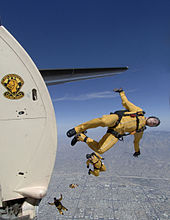 U.S. Army Golden Knights Parachute Team at the 2007 "Aerospace and Arizona Days" air show, Davis-Monthan Air Force Base.
U.S. Army Golden Knights Parachute Team at the 2007 "Aerospace and Arizona Days" air show, Davis-Monthan Air Force Base.
- USAAS-USAAC-USAAF-USAF Aircraft Serial Numbers--1908 to present
- Davis-Monthan Air Force Base Newspaper, Desert Lightning News
- Davis-Monthan Air Force Base Official Homepage
- Davis-Monthan Army Airfield in World War II
- Davis-Monthan Air Force Base at GlobalSecurity.org
- Davis-Monthan Agave Gulch FamCamp information.
- Lt Col Harold W. Moll memorial webpage
- Col Moll was assigned to the 444th Bombardment Group and 43d Bombardment Group/Wing at D-M.
- The Short, Happy Life of the Glick-Em
- Arizona activates ANG Predator unit at D-M
- FAA Airport Diagram (PDF), effective 20 October 2011
- Resources for this U.S. military airport:
- AirNav airport information for KDMA
- ASN accident history for DMA
- NOAA/NWS latest weather observations
- SkyVector aeronautical chart for KDMA
- Davis-Monthan Air Force Base at Google Maps
 Air Combat Command (ACC)
Air Combat Command (ACC)Air Forces 
Center Bases Wings BombCompositeFighterOther9th Reconnaissance · 98th Range · 99th Air Base · 505th Command and Control · 552nd Air Control · 633d Air BaseLinks to related articles Bases CONUSAdair · Beale · Bong (unbuilt) · Charleston · Davis-Monthan · Dobbins · Dover · Dow · Duluth · England · Ent · Ethan Allen · Fairfax · Fort Lee · Geiger · George · Glasgow · Grand Forks · Grenier · Griffiss · Gunter · Hamilton · Hancock · Homestead · Hurlburt · Imeson · K.I. Sawyer · Kincheloe · Kingsley · Kirtland · Larson · Luke · March · Malmstrom · McCoy · McChord · McClellan · McGhee Tyson · McGuire · Minneapolis-St. Paul · Minot · Mitchel · New Castle · Niagara Falls · Norton · O'Hare · Oklahoma City · Otis · Oxnard · Paine · Perrin · Peterson · Pittsburgh · Pope · Portland · Presque Isle · Richards-Gebaur · Selfridge · Seymour Johnson · Sioux City · Snelling · Stead · Stewart · Suffolk County · Tinker · Travis · Truax · Tyndall · Vandenburg · Webb · Westover · Willow Run · Wright-Patterson · Wurtsmith · Youngstown
OverseasErnest Harmon · Frobisher Bay · Goose Bay · Keflavik · Pepperrell · Thule · Topsham

Stations CONUSAlmaden · Charleston · Clear · Cross City · Benton · Empire · Mill Valley · Montauk · Mount Hebo · North Truro · Point Arena · Rye · Thomasville · Watertown
OverseasAlbrook
Air
Defense
unitsForcesAir
DivisionsSectorsAlbuquerque · Bangor · Boston · Chicago · Detroit · Duluth · Goose · Grand Forks · Great Falls · Iceland · Kansas City · Los Angeles · Minot · Montgomery · New York · Oklahoma City · Phoenix · Portland · Reno · Sault Sainte Marie · San Francisco · Seattle · Sioux City · Spokane · Stewart · Syracuse · Washington
WingsGroups1st · 4th · 10th · 14th · 15th · 23rd · 32nd · 33rd · 50th · 52nd · 53rd · 54th · 56th · 57th · 73rd · 78th · 79th · 81st · 82nd · 84th · 325th · 326th · 327th · 328th · 329th · 337th · 355th · 408th · 412th · 414th · 473rd · 475th · 476th · 478th · 500th · 501st · 502d · 503d · 507th · 514th · 515th · 516th · 517th · 518th · 519th · 520th · 521st · 525th · 527th · 528th · 529th · 530th · 533d · 534th · 564th · 566th · 567th · 568th · 575th · 678th · 701st · 4676th · 4700th · 4721st · 4722d · 4727th · 4728th · 4729th · 4730th · 4731st · 4732d · 4733d · 4734th · 4735th · 4756th
SquadronsAerospace Defense Command Fighter Squadrons · Aircraft Control and Warning Squadrons
Major
weapon
systemsElectronicFightersMissiles1 · 2 · 3 · 4 · 5
ShipsGuardian · Interceptor · Interdictor · Interpreter · Investigator · Locator · Lookout · Outpost · Pickett · Protector · Scanner · Searcher · Skywatcher · Tracer · Watchman · Vigil
Miscellaneous Air Defense Command Emblem Gallery (On Wikimedia Commons) · General Surveillance Radar Stations Strategic Air Command (SAC)
Strategic Air Command (SAC)Bases Active
(MAJCOM)CONUSAltus (AETC) • Andersen (PACAF) • Andrews (AMC) • Barksdale (ACC) • Beale (ACC) • Bolling (AFDW) • Cannon (AFSOC) • Columbus (AETC) • Davis-Monthan (ACC) • Dyess (ACC) • Eielson (PACAF) • Ellsworth (ACC) • Eglin (AFMC) • F. E. Warren (AFSPC) • Fairchild (AMC) • Forbes (ANG) • Grand Forks (AMC) • Grissom (AFRC) • Homestead (AFRC) • Lincoln (ANG) • Little Rock (AETC) • MacDill (AMC) • Malmstrom (AFSPC) • March (AFRC) • McChord (AMC) • McConnell (AMC) • McGuire (AMC) • Minot (ACC) • Mountain Home (ACC) • Nellis (ACC) • Offutt (ACC) • Patrick (AFSPC) • Pease (ANG) • Rickenbacker (ANG) • Robins (AFMC) • Seymour Johnson (ACC) • Sheppard (AETC) • Selfridge (ANG) • Travis (AMC) • Vandenburg (AFSPC) • Westover (AFRC) • Whiteman (ACC) • Wright-Patterson (AFMC)
OverseasRAF Alconbury (USAFE) • Diego Garcia (RAF) • Kadena (PACAF) • RAF Fairford (USAFE) • RAF Lakenheath (USAFE) • RAF Mildenhall (USAFE) • Thule (AFSPC)
InactiveCONUSAmarillo • Bergstrom • Biggs • Bong (unbuilt) • Calumet Air Force Base • Carswell • Castle • Chennault • Clinton-Sherman • Dow • Eaker • Glasgow • Grand Island (AAF) • Griffiss • Hunter • K. I. Sawyer • Kearney • Kincheloe • Larson • Loring • Lowry • Mather • McCoy • Plattsburgh • Presque Isle • Ramey • Shilling • Stead • Turner • Walker • Wurtsmith
OverseasRAF Bassingbourn • Ben Guerir • Boulhaut • RAF Brize Norton • RAF Bruntingthorpe • RAF Burtonwood • RAF Chelveston • RAF Greenham Common • Goose Bay • Ernest Harmon • RAF High Wycombe • RAF Upper Heyford • Torrejón • RAF Manston • Morón • Nouasseur • RAF Scampton • RAF Sculthorpe • Sidi Slimane • RAF South Ruislip • U-Tapao • RAF Waddington • RAF Woodbridge • RAF Wyton • Zaragoza

Units Air ForcesSecond Air Force • Eighth Air Force • Fifteenth Air Force • Sixteenth Air Force • Twentieth Air ForceDivisions AirStrategic
AerospaceStrategic Missile13thReconnaissance6th Strategic Reconnaissance • 26th Strategic Reconnaissance • 55th Strategic Reconnaissance • 544th Aerospace Reconnaissance TechnicalAerospaceAFCONMAJCOM3918th • 3920th • 3960th • 3970th • 3973d • 4026th • 4038th • 4039th • 4042d • 4043d • 4047th • 4080th • 4081st • 4082d • 4083d • 4123d • 4126th • 4128th • 4130th • 4133d • 4134th • 4135th • 4136th • 4137th • 4138th • 4141st • 4157th • 4158th • 4170th • 4228th • 4238th • 4239th • 4241st • 4245th • 4252nd • 4258th • 4321stSupportUSAAF
Groups
*=Initial Assigned
Unit Upon SAC's
ActivationBombardmentFighter27th (6/47) • 55th (2/47)Reconnaissance91st Strategic Reconnaissance (1/47)Major
weapon
systemsBombersCommand
& ControlFightersMissilesReconnaissanceTankersTransportCommanders Emblems Strategic Air Command Emblem Gallery (On Wikimedia Commons) Tactical Air Command (TAC)
Tactical Air Command (TAC)Air Forces 
Air Divisions 20th (ADTAC) · 21st (ADTAC) · 23rd (ADTAC) · 24th (ADTAC) · 25th (ADTAC) · 26th (ADTAC) · 28th (ADTAC) · 831st · 832nd · 833rd · 834th · 835th · 836th · 837th · 838th · 839th · 840thNamed units Wings TFWOther1st SOW · 57th FWW · 63rd TAW · 64th TAW · 67th TRW · 75th TRW · 85th TFTW · 317th TAW · 363rd TRW · 405th TFTW · 461st TBW · 4505th ARWFormer
basesActive
(MAJCOM)Altus (AETC) · Brooks (AFMC) · Cannon (AFSOC) · Charleston (AMC) · Creech (ACC) · Davis-Monthan (ACC) · Dover (AMC) · Dyess (ACC) · Eglin (AFMC) · Hill (AMFC) · Holloman (ACC) · Hurlburt Field (AFSOC) · Langley (ACC) · Little Rock (AETC) · Luke (AETC) · MacDill (AMC) · McChord (AMC) · McConnell (AMC) · Moody (ACC) · Mountain Home (ACC) · Nellis (ACC) · Pope (AMC) Seymour Johnson (ACC) · Shaw (ACC) · Tonopah (ACC) · Tyndall (AETC) · Whiteman (ACC)InactiveInactive, but with a military presenceAircraft A-1 · A-7 · A-10 · A-37 · AC-47 · AC-119 · AC-130 · B-26 · B-57 · B-66 · C-7 · C-47 · C-82 · C-119 · C-123 · C-130 · E-3 · E-8 · EF-111 · EC-135 · F-4 · F-5 · F-15 · F-16 · F-47 · F-51 · F-80 · F-82 · F-84 · F-86 · F-89 · F-100 · F-101 · F-102 · F-104 · F-105 · F-106 · F-111 · F-117 · H-1 · H-5 · H-6 · H-19 · H-43 · H-60 · H-53 · KB-29 · KB-50 · KC-97 · O-1 · O-2 · OH-23 · OV-10 · P-40 · P-38 · R-4 · S-62 · T-6 · T-28 · T-29 · T-33 · T-38 USAAF Second Air Force in World War II
USAAF Second Air Force in World War IIAirfields Group Training Stations · Heavy Bombardment Training Stations · Replacement Training Stations · Tactical Airfields · Very Heavy Bomber Bases
Units Commands II Air Support Command · II Bomber Command · II Fighter Command · IV Air Support Command · XX Bomber Command · XXI Bomber Command · XXII Bomber CommandWings 5th Bombardment · 15th Bombardment Training · 16th Bombardment Operational Training · 17th Bombardment Training · 18th Replacement · 21st Bombardment · 46th Bombardment Operational Training · 58th Bombardment · 73d Bombardment · 315th Bombardment · 316th BombardmentGroups Bombardment 2d Bombardment · 6th Bombardment · 7th Bombardment · 9th Bombardment · 12th Bombardment · 16th Bombardment · 17th Bombardment · 19th Bombardment · 25th Bombardment · 29th Bombardment · 34th Bombardment · 39th Bombardment · 40th Bombardment · 42d Bombardment · 46th Bombardment · 47th Bombardment · 48th Bombardment · 85th Bombardment · 86th Bombardment · 86th Bombardment · 88th Bombardment · 94th Bombardment · 95th Bombardment · 96th Bombardment · 99th Bombardment · 100th Bombardment · 301st Bombardment · 302d Bombardment · 303d Bombardment · 304th Bombardment · 305th Bombardment · 306th Bombardment · 307th Bombardment · 308th Bombardment · 312th Bombardment · 330th Bombardment · 331st Bombardment · 333d Bombardment · 346th Bombardment · 351st Bombardment · 376th Bombardment · 379th Bombardment · 381st Bombardment · 382d Bombardment · 383d Bombardment · 384th Bombardment · 385th Bombardment · 388th Bombardment · 390th Bombardment · 393d Bombardment · 395th Bombardment · 396th Bombardment · 398th Bombardment · 399th Bombardment · 400th Bombardment · 401st Bombardment · 407th Bombardment · 415th Bombardment · 418th Bombardment · 444th Bombardment · 445th Bombardment · 446th Bombardment · 447th Bombardment · 448th Bombardment · 449th Bombardment · 450th Bombardment · 451st Bombardment · 452d Bombardment · 453d Bombardment · 454th Bombardment · 455th Bombardment · 456th Bombardment · 457th Bombardment · 458th Bombardment · 459th Bombardment · 460th Bombardment · 461st Bombardment · 462d Bombardment · 464th Bombardment · 467th Bombardment · 468th Bombardment · 469th Bombardment · 470th Bombardment · 471st Bombardment · 472d Bombardment · 484th Bombardment · 485th Bombardment · 486th Bombardment · 487th Bombardment · 488th Bombardment · 489th Bombardment · 490th Bombardment · 491st Bombardment · 493d Bombardment · 494th Bombardment · 497th Bombardment · 498th Bombardment · 499th Bombardment · 500th Bombardment · 501st Bombardment · 502d Bombardment · 504th Bombardment · 505th Bombardment · 509th CompositeFighter Reconnaissance 2d Reconnaissance · 3d Reconnaissance · 4th Reconnaissance · 5th Reconnaissance · 6th Reconnaissance · 7th Reconnaissance · 8th Reconnaissance · 71st Reconnaissance · 77th ReconnaissanceTroop Carrier 443d Troop CarrierCurrent military installations of ArizonaArmy  Air FieldDepotNavajoFortHeliportRangeCamp Florence • Camp Navajo • Western Army National Guard Aviation Training Site
Air FieldDepotNavajoFortHeliportRangeCamp Florence • Camp Navajo • Western Army National Guard Aviation Training Site
Marines  Air StationRange
Air StationRangeAir Force  Davis-Monthan • LukeAuxiliary FieldRange
Davis-Monthan • LukeAuxiliary FieldRangeAirports with boneyards Pinal Airpark · Davis-Monthan Air Force Base · Southern California Logistics Airport · Roswell International Air Center · Phoenix Goodyear Airport · Abilene Regional Airport · Mojave Air & Space Port Categories:
Categories:- 1925 establishments
- Airfields of the United States Army Air Corps
- USAAF Second Air Force Heavy Bombardment Training Stations
- Initial United States Air Force installations
- Bases of the United States Air Force
- Airports in Pima County, Arizona
- University of Arizona
- Military facilities in Arizona
- Strategic Air Command
- Economy of Tucson, Arizona
- Aircraft boneyards
- Transportation in Tucson, Arizona
- Buildings and structures in Tucson, Arizona
- Airfields of the United States Army Air Forces in Arizona
- Border guards
Wikimedia Foundation. 2010.


